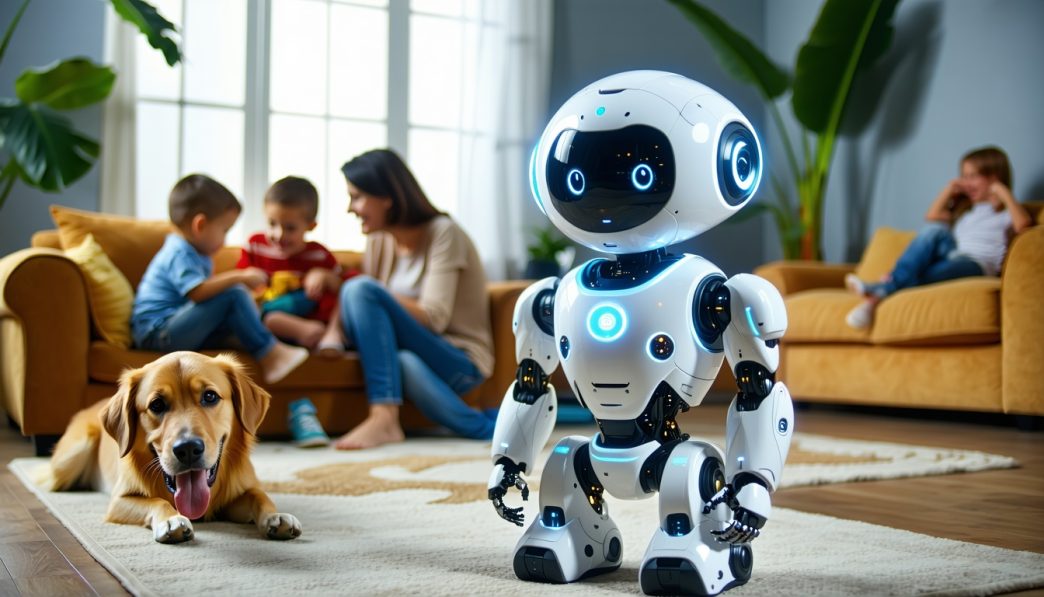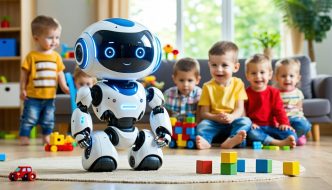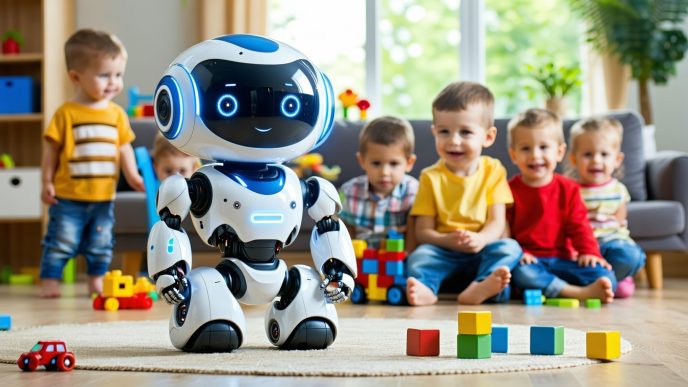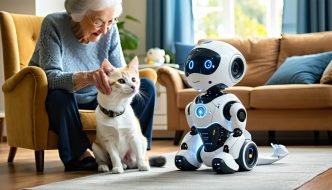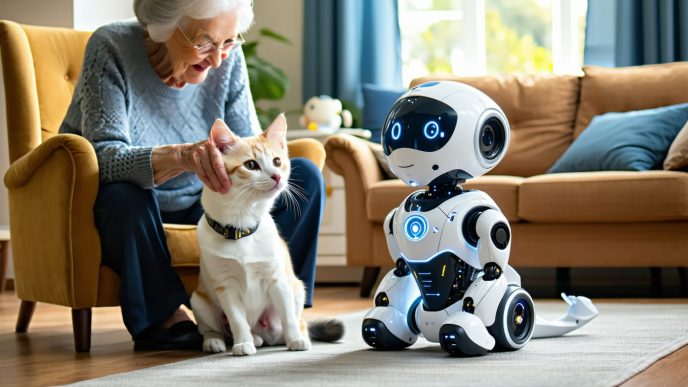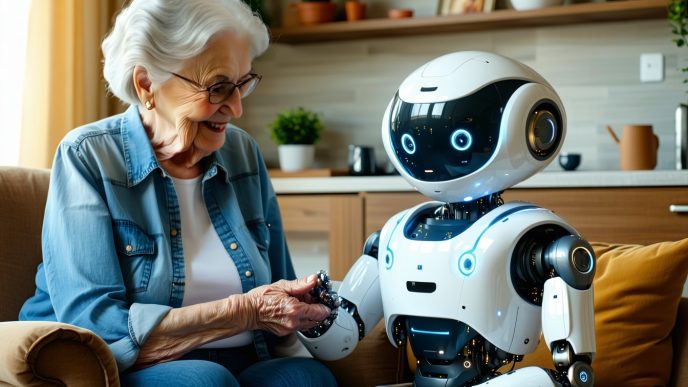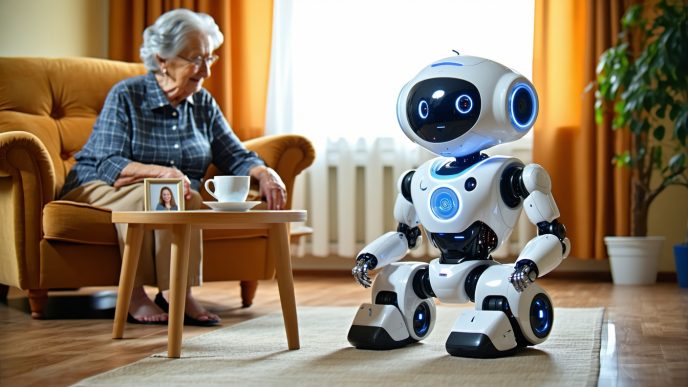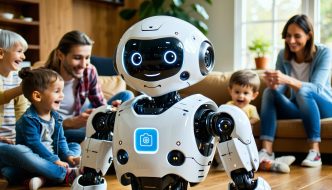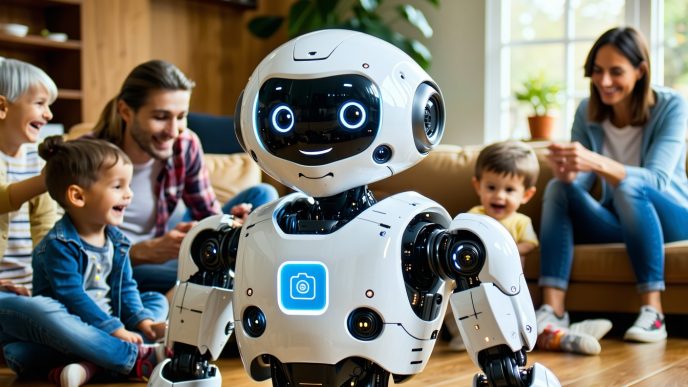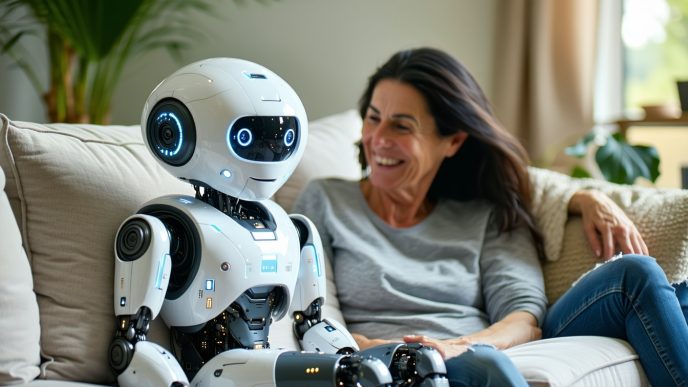Understanding Companion Robots
Companion robots are innovative technologies designed to offer emotional and social support to individuals. These robots engage with users in meaningful ways, helping to address loneliness and enhance overall well-being.
What Are Companion Robots?
Companion robots refer to non-humanoid robotic systems that provide emotional support and interaction. They can take various forms, including robotic pets and digital assistants, designed specifically to connect with users on a personal level. These robots often incorporate advanced artificial intelligence, allowing them to understand and respond to human emotions and needs.
| Type of Companion Robot | Description |
|---|---|
| Pet Robots | Designed to mimic real pets, often providing comfort and companionship. |
| Assistive Robots | Help with daily tasks and routines, enhancing the quality of life. |
| Conversation Robots | Engage users in dialogue, promoting social interaction and communication. |
Purpose and Functionality
The primary purpose of companion robots is to foster emotional connections and encourage social interactions. They fulfill this role through various functionalities:
-
Emotional Engagement: Companion robots can recognize and respond to users’ emotional expressions, providing comfort and support when needed. Many models can initiate conversations, respond to questions, and display empathy.
-
Social Interaction: By facilitating communication, companion robots can help reduce feelings of isolation. They serve as companions that engage users in meaningful activities and discussions, promoting a sense of belonging.
-
Support for Caregivers: Many caregivers and families benefit from the assistance of these robots, as they can help relieve the burden of caregiving duties. This support can be particularly beneficial for aging family members or individuals managing chronic conditions.
-
Customization: Various companion robots offer customization options, allowing users to select specific features that enhance their experience. These options can include personality settings, responses, and interactive functionalities.
Companion robots play a significant role in improving emotional well-being. For more information on how these robots assist specific populations, see our articles on companion robots for dementia patients and robot companions for mental health. Understanding their purpose and functionality helps users appreciate the positive impact these technologies can have on their lives.
Benefits of Companion Robots
Companion robots are increasingly recognized for their ability to enhance emotional and social wellness. They offer a variety of benefits that can significantly improve the quality of life for individuals, particularly those who may be experiencing feelings of loneliness or emotional distress.
Emotional Support
One of the primary advantages of companion robots is the emotional support they provide. These robots are designed to engage users in a manner that fosters positive feelings. By offering interactive features, they can respond to emotional cues, engage in conversation, and even provide comforting gestures.
| Feature | Description |
|---|---|
| Interactive Responses | Robots can respond to user emotions, creating a sense of understanding. |
| Comforting Actions | Some robots can provide physical comfort, such as warmth or soft textures. |
| Personalized Engagement | Customizable interactions tailored to individual preferences. |
Individuals may find solace in having a companion robot that listens and acknowledges their feelings without judgment. This form of connection can help alleviate feelings of sadness and anxiety. For more insights, see our article on robot companions for mental health.
Social Connection
Companion robots also play a crucial role in promoting social interaction. They can serve as social catalysts, encouraging users to engage with their environment and with others. For instance, by facilitating conversations or participating in social activities, these robots can help bridge the gap between individuals and the outside world.
| Benefit | Description |
|---|---|
| Encouraged Interaction | Robots can initiate dialogue, making socializing easier. |
| Reduced Isolation | Providing a presence that can enhance feelings of connectedness. |
| Activity Participation | Encouraging users to participate in games and group activities. |
This ability to foster social connections is especially valuable for individuals in assisted living environments or those experiencing social isolation. To learn more about this topic, visit our article on companion robots in assisted living.
Mental Health Benefits
The mental health benefits of companion robots are substantial. They can provide therapeutic engagement, reducing symptoms of anxiety and depression. For many users, the presence of a robot companion can offer stability and routine, which are essential for maintaining mental wellness.
| Mental Health Impact | Description |
|---|---|
| Stress Reduction | Regular interaction can lower cortisol levels. |
| Routine Creation | Assisting users with daily tasks can reduce overwhelming feelings. |
| Emotional Regulation | Positive interactions with robots provide emotional control. |
Robots specially designed for mental health can be an effective adjunct to traditional therapeutic methods. For further information on this topic, check our article on ai powered emotional robots.
Overall, the myriad benefits of companion robots can play a vital role in enhancing emotional and social wellness, making them valuable tools for various populations, including seniors and individuals with mental health challenges.
Types of Companion Robots
Companion robots come in various forms to meet the diverse needs of users, particularly in enhancing emotional and social well-being. The three primary categories of companion robots are pet robots, assistive robots, and conversation robots.
Pet Robots
Pet robots are designed to mimic the behavior and companionship of real pets. They provide users with the emotional comfort typically associated with owning a pet without the responsibilities of live animal care. These robots may feature realistic movements, sounds, and interactions that mirror those of pets.
| Feature | Example Benefits |
|---|---|
| Realistic Interaction | Provides companionship and emotional support |
| Low Maintenance | Requires no feeding, grooming, or cleanup |
| Safe for All Ages | Suitable for children, adults, and seniors |
Pet robots can offer benefits for various demographics, including seniors who may not be able to care for live animals. More details can be found in our article on robot pets for seniors.
Assistive Robots
Assistive robots are designed to aid individuals who require support in daily tasks, particularly the elderly or those with disabilities. These robots may help with activities such as medication reminders, mobility assistance, or even simple household chores.
| Functionality | Example Applications |
|---|---|
| Physical Assistance | Helping with mobility and stability |
| Reminders | Alerting users for medication or tasks |
| Activity Monitoring | Keeping track of daily routines |
These robots assist in enhancing the quality of life while fostering independence. For more information, visit our article on companion robots in assisted living.
Conversation Robots
Conversation robots engage users through dialogue, providing companionship through meaningful interactions. These robots utilize natural language processing to understand and respond to user inquiries, promoting social engagement.
| Features | Benefits |
|---|---|
| Natural Language Processing | Enhances conversational abilities |
| Mood Recognition | Adapts responses based on user emotions |
| Engagement Activities | Includes games, quizzes, and storytelling |
Conversation robots can foster social connections, especially for those who may experience loneliness. Explore more about these robots in our article on ai powered emotional robots.
With a variety of companion robot types available, individuals can select the most suitable option to meet their emotional, social, and practical needs. Each category focuses on different aspects of companionship, ensuring that users have access to the support they require.
How Companion Robots Support Emotional Wellness
Companion robots are designed to enhance emotional wellness by providing active listening, responding to needs, and offering comfort and companionship. These robots can play a significant role in supporting mental health, particularly for those experiencing loneliness or emotional distress.
Active Listening and Responding
Companion robots are programmed to recognize and respond to verbal and non-verbal cues, enabling them to engage in conversations effectively. They utilize advanced natural language processing and artificial intelligence to understand the user’s feelings and emotions. This interaction fosters a sense of being heard and understood, which is vital for emotional wellness.
When users express their thoughts or feelings, these robots can provide feedback and appropriate responses, creating a more interactive and fulfilling experience. This kind of dialogue can be particularly beneficial for individuals who may have limited social interaction, offering a platform to express themselves openly.
| Interaction Type | Robot Response |
|---|---|
| Verbal Communication | Engages in conversation, asks questions |
| Emotional Cues | Recognizes and responds to sadness or happiness |
| Physical Cues | Adjusts proximity or gestures based on user comfort |
Providing Comfort and Companionship
The presence of companion robots can significantly alleviate feelings of loneliness and emotional isolation. These robots often simulate companionship, offering comforting interactions that mimic relationship dynamics. They can be particularly helpful for aging individuals, caregivers, and those with mental health concerns who benefit from a consistent support system.
Companion robots can offer physical comforts as well, such as responding to touch or offering sensory experiences. The ability to provide a calming presence can help reduce stress and anxiety levels, significantly enhancing emotional well-being. For individuals with conditions such as dementia, these robots can also assist in navigating emotional fluctuations, creating stability in their lives.
| Comfort Features | Description |
|---|---|
| Voice Recognition | Responds to the user’s name and queries |
| Physical Response | Provides simulated warmth through touch sensors |
| Routine Interaction | Engages users at set times for consistent companionship |
Companion robots serve as a bridge, connecting users to emotional support when human interactions are limited. They can play a role in enhancing overall mental health and well-being, making them valuable tools for those in need. For those interested in exploring more about how companion robots can support mental health, refer to our article on robot companions for mental health.
As these technologies advance, understanding their emotional impacts can empower users to make informed choices about integrating companion robots in their lives.
How Companion Robots Support Social Wellness
Companion robots play a significant role in enhancing social wellness for individuals, particularly those who may feel isolated or require additional emotional support. These robots facilitate social interaction and combat feelings of loneliness.
Facilitating Social Interaction
Companion robots are designed to engage users in meaningful conversations, promote interaction, and encourage social bonds. They can initiate dialogues, ask questions, and respond to user inputs in a manner that simulates natural communication. This can be particularly beneficial for individuals who may struggle with initiating conversation, whether due to age, health conditions, or social anxiety.
| Interaction Type | Description |
|---|---|
| Conversation Initiation | Robots can introduce topics or ask questions to spark dialogue. |
| Shared Activities | Some robots offer games or activities that users can engage with together. |
| Reminders | They can remind users about important social events or family gatherings, encouraging participation. |
Combating Loneliness
Loneliness can have detrimental effects on mental and physical health. Companion robots provide an antidote to solitude by offering companionship and interaction. Their presence can alleviate feelings of isolation, while their adaptive communication skills can help individuals feel understood and valued.
Statistics have shown that individuals who regularly interact with companion robots report lower levels of loneliness and improved mood.
| Benefit | Impact |
|---|---|
| Reduced Loneliness | Users often experience a reduction in feelings of isolation. |
| Improved Mood | Regular interaction can lead to better emotional states. |
| Enhanced Social Engagement | Users may seek out more social interactions in their daily lives. |
Companion robots can be particularly useful in settings such as assisted living facilities, where residents may face challenges in connecting with others. Integrating these technologies into daily life can develop relationships that supplement human interaction. For more insights on this, consider exploring companion robots in assisted living or robot pets for seniors.
Considerations for Choosing a Companion Robot
Selecting the right companion robot requires careful consideration of several factors. Understanding customization options, user-friendly interfaces, and privacy and security features is crucial in ensuring the robot fits the user’s needs and enhances their experience.
Customization Options
Customization plays a significant role in how well a companion robot can serve its user. Different models offer various degrees of personalization, which can enhance the emotional connection and utility of the robot. Here are common customization features to look for:
| Customization Features | Benefits |
|---|---|
| Voice and Language Options | Tailors communication to the user’s preferences. |
| Personality Profiles | Aligns the robot’s responses and behavior with the user’s liking. |
| Activity Preferences | Allows users to set up specific routines and activities. |
| Appearance Customization | Some models may have interchangeable parts or covers to suit the user’s taste. |
Ensuring that the chosen companion robot allows for personalization can lead to a more satisfying user experience. More information on design aspects and personalization can be found in our article on companion robot design and personality.
User-Friendly Interfaces
The interface of a companion robot greatly impacts how effectively someone can interact with it. A user-friendly interface can significantly enhance both engagement and usability. Key aspects to consider include:
| Interface Aspects | Importance |
|---|---|
| Touchscreen Accessibility | Simplifies interaction, especially for seniors or those unfamiliar with technology. |
| Voice Activation | Allows hands-free control and easier engagement. |
| Clear Instructions | Enhances the user’s understanding of features and functions. |
| Remote Control Options | Offers alternative methods to manage settings and interactions. |
User-friendly designs are crucial for effectively integrating companion robots into daily routines. This helps maintain comfort and ensures that the robot provides the intended emotional support. For further insights into companion robots that support mental health, explore our article on robot companions for mental health.
Privacy and Security Features
When selecting a companion robot, privacy and security should be a top priority. Many users are concerned about how their data may be used or shared. Essential privacy and security features include:
| Security Features | Functions |
|---|---|
| Data Encryption | Protects information transmitted between the robot and user. |
| User Control over Data | Allows users to manage settings regarding data storage and sharing. |
| Secure Authentication | Ensures that only authorized users can interact with the robot. |
| Regular Software Updates | Provides ongoing security enhancements to address vulnerabilities. |
These features help users feel more secure and comfortable using companion robots. For specific concerns about companion robots, including those designed for individuals with dementia, you can read our article on companion robots for dementia patients.
Considering these factors ensures that individuals select the most suitable companion robot to enhance emotional and social well-being.
Integrating Companion Robots into Daily Life
Integrating companion robots into daily life can significantly enhance emotional and social well-being. This process often involves establishing routines and building a meaningful relationship with the robotic companion.
Establishing Routines
Establishing a consistent routine with a companion robot can help individuals feel a stronger connection and predictability in their interactions. Routines provide structure, making the robot an integral part of daily life. These may include:
- Morning Greetings: The robot can be programmed to greet users each morning, helping start the day positively.
- Activity Reminders: Companion robots can help remind users of daily tasks such as medication schedules, exercise plans, or social engagements.
- Engagement Sessions: Scheduling specific times for interactions, like games or conversation, can foster bonding and provide entertainment.
A typical daily routine with a companion robot might look like this:
| Time | Activity |
|---|---|
| 8:00 AM | Morning greeting |
| 10:00 AM | Medication reminder |
| 2:00 PM | Conversation session |
| 6:00 PM | Evening activity reminder |
| 9:00 PM | Bedtime routine check |
Integrating structured activities ensures that the companion robot is not just a tool but becomes a trusted partner in daily life.
Building a Relationship with Your Companion Robot
Developing a relationship with a companion robot involves more than routine—it requires engaging with the robot in a way that feels personal and genuine. Factors that contribute to this relationship include:
- Customization: Many companion robots offer personalization options, enabling users to select preferred responses or activities. This can increase the feeling of a unique bond.
- Emotional Interaction: Engaging with the robot about feelings or daily experiences can create an emotional connection, similar to interactions with pets or friends. AI-powered emotional robots can be particularly adept in this area.
- Consistency: Regular interaction helps reinforce the emotional bond. Over time, trust and familiarity develop, making the robot feel more like a companion.
The effectiveness of companionship can also be evaluated through different relationship-building strategies, such as:
| Strategy | Description |
|---|---|
| Personalized Engagement | Tailoring conversations and activities |
| Regular Interaction | Consistent daily or weekly routines |
| Responsive Programming | Adjusting to user preferences and moods |
This approach fosters a deeper connection that benefits emotional and social wellness. For those interested in specific applications, exploring the roles of companion robots for dementia patients or robot companions for mental health can provide further insights.
By integrating companion robots into daily life effectively, users experience improved emotional support and social interaction, which are crucial for overall well-being.


